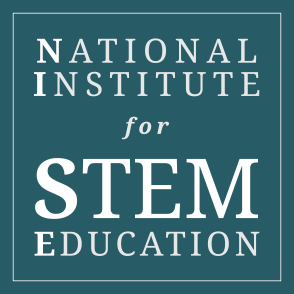Most teachers we talk to agree that their students struggle with critical thinking, problem-solving ability, and reasoning. We also know that many students lack the skills they need to read information, extract important points within the text, and synthesize what they have read (Barrow, 2006).
So, how can we remedy this problem and better prepare our students for the workforce? At NISE, we believe the answer is to immerse students in STEM learning. STEM can be understood as simply integrating the fields of science, technology, engineering, and mathematics. Or, it can describe an approach to learning that enables students to take an active role in the asking of questions and solving of problems. This second interpretation applies a STEM mindset to all disciplines, not only science, technology, engineering, and mathematics.
Noted educator and philosopher John Dewey viewed learning as an active process, one that allows students to interact with their environment, actively connecting their learning to their interests and lives outside of school. This type of learning environment is characteristic of STEM. If we are to move toward that type of learning, we must change our approach to instruction accordingly. For students to be successful at constructing extensive and flexible knowledge that moves beyond memorization of basic definitions and facts from a lecture, they must become responsible for their learning (Hmelo-Silver, 2004).
Teachers in all subject areas can be STEM teachers. STEM does not require robotics clubs, after-school activities, or expensive technology. We believe that STEM can be incorporated just about anywhere, with any available resources. STEM teaching does not require a shift in what is taught: It requires a shift in how we teach.
How do you make content standards more STEM-oriented? Use these guiding principles to create standards-aligned, rich learning experiences for your students.
- Start with your standards. Are there opportunities to provide students more hands-on, collaborative, or inquiry-based experiences? Which content topics have you typically taught through lecture? Could they be made more student-centered? Identify potential areas that can be shifted toward STEM in your content area.
- Remember that STEM requires risk-taking for students. Create a safe place for students to move outside of their comfort zones. In a safe classroom, students can practice and develop skills that will be helpful not only for the mastery of content but also for their lives outside of school—and their future.
- Utilize collaborative learning. The STEM workforce requires collaboration, problem solving, creativity, and critical thinking. Research shows that collaboration among students improves learning outcomes. Why not leverage collaborative learning for its benefit in the mastery of content and skills?
- Allow student choice. Many of us do not have the luxury of allowing students to choose what they study. However we may be able to increase student ownership over the learning experience by finding ways for students to make choices. For example, sixth grade students in Texas learn about the world's cultures. The teacher might choose a cluster of cultures at a time to provide more structure for the learning—perhaps those that would be assessed together. Then, within that cluster, allow for student choice.
- Increase student voice. One quick, easy way to assess the degree to which a classroom is student centered is to compare the amount of talking done by the teacher with the amount of talking taking place among students. By allowing students to have more of a voice, STEM teachers will see an increase in student engagement, motivation, and interest in learning.
- Extend learning beyond the classroom walls. A STEM student should, at all times, be able to express how their learning connects is to what is happening outside of school. This may mean that students are applying what they have learned in a service learning project or are investigating potential solutions to a problem. It may also mean that they are provided opportunities to speak about their learning in public venues. Or, it could mean that they interact with students from other classrooms, or even other schools or countries, to share what they have learned. In any case, STEM learning must be "real" to students so that they carry it with them when they leave the school building.
STEM does not have to be overly complicated or materials-intensive Consider these two examples of lessons about flower anatomy. In one lesson, students learn the parts of a flower by labeling a diagram after reading from a textbook or listening to a presentation by the teacher. In another lesson, students bring flowers from their homes or their walk to school and dissect them, observing and comparing their parts. With this small shift toward student-centered learning, the opportunities for discussion, collaboration, and meaningful understanding have increased ten-fold.
At NISE, we hope that every teacher, regardless of their content area, will take advantage of opportunities to put the student at the center of their lessons. We hope they will utilize the STEM philosophy to construct lessons to better prepare their students for their lives outside of school. And, we hope that they will understand that STEM doesn't have to just mean the integration of science, technology, engineering, and math. We hope that all teachers will recognize the benefit and value of the STEM mindset, and with these simple tips, begin placing STEM at the heart of their standards-aligned instruction.
